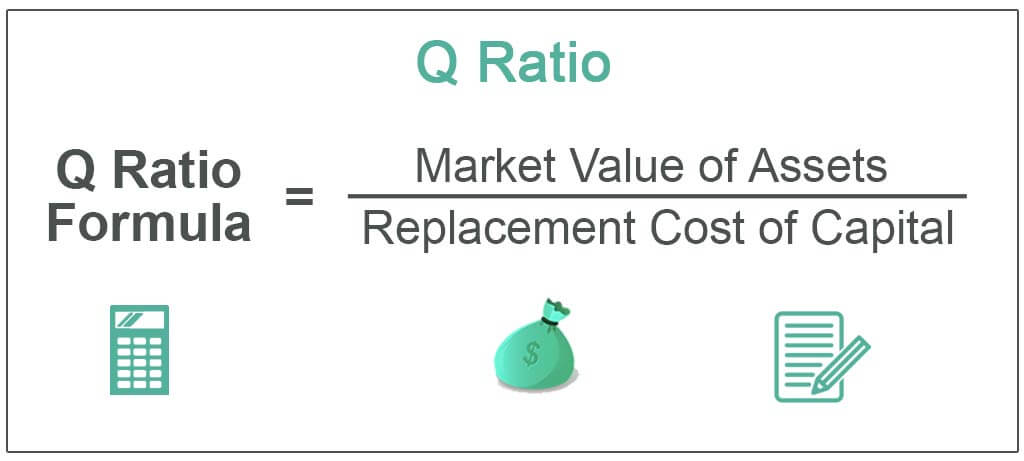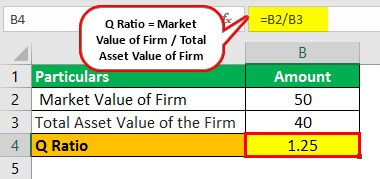Table Of Contents
What Is The Q Ratio?
Q Ratio is used to determine the valuation of the company or the market at large to know whether it is overvalued or undervalued and is calculated as the ratio of the market value of the company's physical assets and the net worth of the company. This ratio was developed by James Tobin, an expert and Nobel Laureate in economics, and is used in amalgamations, mergers, and other valuation models to determine the company's actual worth.
- If the Q ratio is greater than one, it indicates that the company is earning well and has good returns. It is an indication that if the company goes into liquidation, then the investors' funds are safe, and the company's assets are capable enough to repay all the debts.
- If the ratio is lower than 1, it indicates that the company's worth is undervalued. A ratio equal to 1 indicates that the company or market is fairly valued.
The formula of Q Ratio
Q Ratio = Market Value of Assets / Replacement Cost of Capital
Where,
- The market value of assets reflects all the assets' current market value, whether movable or immovable.
- Replacement cost indicates that if assets are sold today, then what will be the value that the company can collect if it liquidates.

Eventually, the valuers find it difficult to determine the replacement cost of all the assets. Hence the ratio was modified as under:
Q Ratio = Market Value of Equity + Market Value of Liabilities / Book Value of Equity + Market Value of Liabilities.
The formula for the overall market is as under:
Q Ratio = Value of Stock Market / Corporate Net Worth.
- The value of the stock market is the value of all the securities listed on the stock market, and corporate net worth is the sum of the net worth of all the companies listed on the stock market.
Example
The Book Value of Assets of the company is $ 40 Million, and the company has 5 Million shares outstanding trading at $ 10/ share. Determine the Q ratio and analyze whether the company is earning well and enjoying benefits or is undervalued based on your calculations.
Solution
Calculation of Q Ratio can be done as follows -

- = 50/40
- = 1.25
As the ratio is greater than 1, the company is performing well and enjoying goodwill.
Uses

Determine the Value of the Company
It is used to determine the company's value to evaluate whether the securities are overvalued or undervalued.

Image Source: FInancial Modeling and Valuation Course
Valuation of Company or Goodwill
It is commonly used in the valuation of a company in case of sale or absorption of the company to determine the true value. It is also used in determining the value of goodwill as if the ratio is greater than 1; it shows that the company has goodwill, and because of it, the company is earning well.

Image Source: Valuation Course
Used in Amalgamation, Mergers, and De-Mergers
It is useful in amalgamations, mergers, and de-mergers to determine the company's value to compensate the shareholders based on the valuation and Q Ratio.
- Banks also use it to approve the loan and determine the repayment capacity.
- Liquidators use it at times of valuation to analyze the position and worth of the company.
- Credit rating agencies also use it to analyze the ratings to be given to the company.
Applications
- It is commonly used in the company's valuation, the valuation of goodwill, etc.
- Banks and financial institutions apply this ratio to know the worth of a potential client.
- It is applied to know the company's real net worth and standing in the market.
- Foreign or International investors apply the market Q Ratio to determine whether the investment will be beneficial or not.
- It is also applied by analysts to analyze the position of a particular company or market at large to estimate future situations.
Advantages
- Helpful in amalgamation, merger, and other transactions to determine the actual net worth.
- Helpful in analyzing the benefits of investment.
- With Q Ratio, the potential of the market can be determined.
- It is an effective tool for attracting foreign investment.
- The market volatility can be controlled to the extent with the help of this ratio.
Disadvantages
- It is calculated based on market value, and the market is always ascertained, i.e., market situations can change positively or negatively.
- The real potential of the company is ignored while calculating the Q Ratio.
- Some companies got the under-valuation price due to the calculation method by the market value approach.
- Sometimes it becomes very difficult to determine the market value because of unique features or self-created assets.

